Chess and stress
By Prof. Christian Hesse and Frederic Friedel
In the previous section (here is part one) we concluded that the risk of dying from heart attack or stroke induced by a slow game of chess is less than half compared to spending the corresponding time not at the chess board, but living an average day with its corresponding everyday risks for heart attack and stroke. So in this respect chess is good for us and clearly risk-reducing.
The fact that during an important game of chess your heart is stressed is one aspect that relates to the question of whether chess is healthy or not. Under cardiovascular aspects, an activity is normally considered quite healthy if it increases your pulse to somewhat above average levels.
Research on the pulse rate of chess players during a game began 45 years ago, in 1979. There was a grand international GM tournament in Munich, at which Helmut Pfleger, a strong grandmaster and medical doctor, carried out tests on the players (of which he was one). The point was to monitor their heart rates during a game.
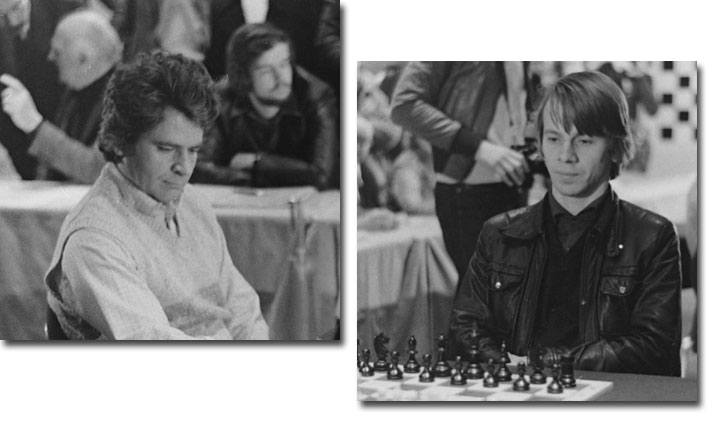
Two volunteers were Boris Spassky and Ulf Andersson, who both wore pulse monitors
Helmut also conducted experiments on himself – in regular games his pulse went up to up to 160 beats per minute. In one game he took a beta blocker that reduces your heart rate. Here the result of that specific experiment:
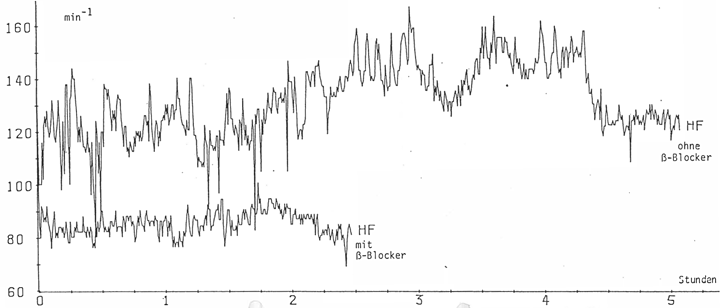
In the graph (click to enlarge) you can see that the pulse rate during a normal game (top line) and one using the beta blocker (bottom line). Helmut was disappointed with his performance when playing "calmly" — apparently the pulse rate highs are required for acute tactical play.
This was a fairly simple experiment — sophisticated monitoring systems were not available at the time. But in the time since then, there have been enormous advances. Recently, an AI group from Intel conducted experiments, including two sessions with leading grandmasters, who played over 150 rated online games each, against other GMs and IMs across the world. A webcam was used to measure the heart rate. A sensor was also used to precisely measure the inter-beat intervals of the heart, from which the cognitive states of the player can be deduced. Let us take a closer look at some of the resulting graphs [click all graphs to enlarge];
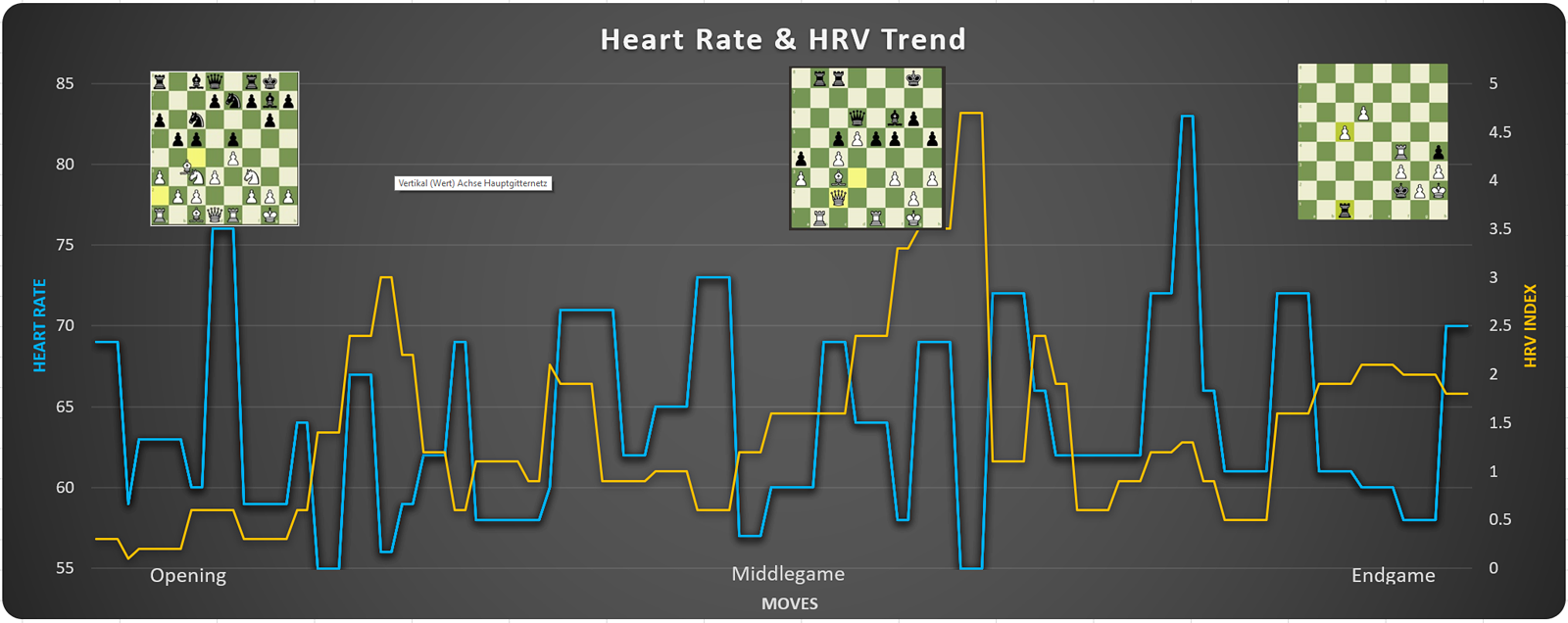
Heart rate and HRV trend
The first graph shows the variations in heart rate and the heart rate variability from the opening to the end of one of the games played by the 2700+ GM. This graph should be interpreted along with the next graph of inter-beat interval.

Heart inter-beat interval trend
The inter-beat interval is the time span between successive heart beats. The human heart does not beat like a metronome. The interval between successive heart beats always varies, in the order of milliseconds. The variability within inter-heart beat intervals is the key to gaining insights into the state of the autonomous nervous system.

Emotion trend
The third graph is a measure of the arousal state (level of excitement) of the player, ranging from relaxed (almost sleepy) to highly excited (sudden surprise/fear). This is computed from heart rate. The 2700+ GM was rarely in a state of high excitement. He has good concentration (indicated by a high HRV index in middle game), combined with moments of calmness.
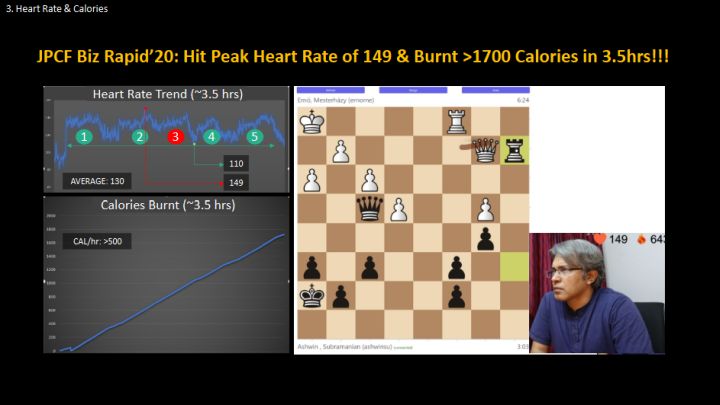
These experiments were conducted by Ashwin Subramanian, a project manager at Intel, a.k.a. “The Heart Rate Guy”. You can read about his work in this ChessBase article.

Above are heart rate results he measured during a game between super-GMs Vidit Gujarathi and Anish Giri. With other players we have observed the heart rate climbing to 170 beats per minute in critical positions during important games.
Fight or flight
In nature the "fight-or-flight" condition is an automatic physiological reaction that occurs in response to a perceived threat or stressful situation. It is a survival mechanism that helps animals to react quickly to danger. When they perceive a threat, their bodies go into high alert mode: the sympathetic nervous system is activated, which releases a flood of hormones, including adrenaline and cortisol. These hormones prepare the body for either fighting the threat or fleeing from it. The physical changes that occur during the fight-or-flight response include:
- Increased heart rate and breathing
- Increased blood pressure
- Dilated pupils
- Sweating
- Tense muscles
- Increased blood sugar levels
These changes give us the energy and strength we need to either fight or flee.
In evolution the fight-or-flight response became an essential part of survival, and helped humans avoid danger for thousands of years. However, in today's world, we often experience stress in situations that are not life-threatening. This can lead to chronic activation of the fight-or-flight response, which can have negative consequences for our health. Or if it occurs in moderation, it can have a positive effect.
Today, the usual way to achieve a high heart rate (and blood pressure) is through sports, or by exercising in a fitness studio. But that is not the only way to give your heart a healthy workout. Apparently, a gripping game of chess can do the same. So this is an aspect of chess that should be considered healthy in the great majority of cases.
On the negative side stands the fact that chess, for the most part, is played while sitting at a table – sometimes for many hours, often motionless or very nearly so. To slightly modify a saying about mathematicians, one might say that “chess players are mythological beings – half human, half chair.”
Some medical experts from the American College of Sports Medicine have identified the extensive sitting of modern humans, at work and at home, as the major health risk of today. They found a strong statistical association between daily sitting time and mortality rates from all causes. They went even so far as to declare chairs our biggest health hazard and they discourage sitting on them for extended periods of time, given that on the average modern adults sit for 10 out of 24 hours. So that obviously is part of the downside of chess.
But the story doesn’t end here. In our final section we will discuss how this and other factors affect the life expectancy of chess players. Care to guess whether the chess playing part of the population can expect to live longer or shorter lives, on average, than the rest of the non-chess people surrounding them?
Also read
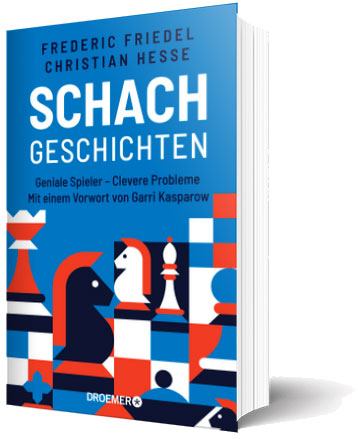
Schachgeschichten – Chess Stories
This book was published in October 2022. It consists of alternating chapters, with Prof. Christian Hesse writing, in his entertaining style, about mathematical aspects of the Royal Game, and Frederic Friedel writing about his encounters with World Champions, of whom he got to know and befriended around a dozen.
The book has been published in German and is endorsed by five world champions (Garry Kasparov wrote the foreword).
If you speak German you can read the first 30 pages here.
The book is available from Amazon for €20. Plans for an English language version are under way.































